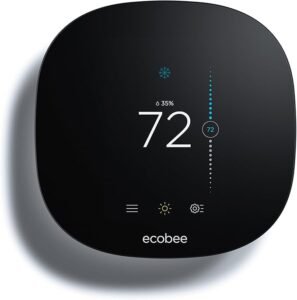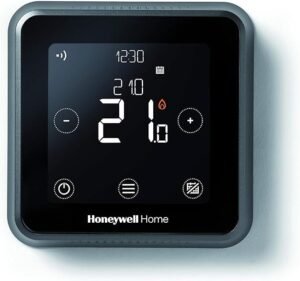What are Smart Thermostats

Imagine a thermostat that learns your habits, anticipates your needs, and adjusts itself to keep you comfortable while saving you money on energy bills. That’s the power of a smart home thermostat!
Essentially, smart thermostats are advanced temperature control devices that go beyond the basic on/off functionality of traditional thermostats. They leverage technology to optimize temperature control, offering a range of benefits that go beyond simply keeping your home warm or cool. Indeed, smart thermostats are more than just advanced temperature controllers, they are a key component of the future smart homes creating a truly interconnected and intelligent home environment through their integration with other smart home devices.
Pros and Cons of Smart Thermostats
| Pros | Cons |
|---|---|
| Significant energy savings | Higher initial cost |
| Enhanced comfort and convenience | Potential installation and setup challenges |
| Remote control via mobile app | Learning curve associated with features |
| Advanced features like geofencing | Privacy concerns regarding data collection |
| some models can improved your integrated home security |
Among the multiple key advantages of Smart Thermostats you can find:
- Unleash Energy Savings: Smart thermostats excel at reducing energy consumption. By learning your household routines, they automatically adjust temperatures when you’re away, maximizing energy efficiency and minimizing your utility bills.
- Effortless Temperature Control: Say goodbye to manual adjustments! With user-friendly mobile apps, you can effortlessly control your home’s temperature from anywhere. Whether you’re on vacation, at work, or simply lounging on the couch, you can ensure your home is always comfortable.
- Advanced Features for Ultimate Convenience: Many smart home thermostats boast advanced features like geofencing, which automatically adjusts temperatures based on your location. This ensures your home is always comfortable when you need it and energy-efficient when you’re away.
- Enhanced Comfort: Experience personalized comfort with features like programmable schedules and customizable temperature settings. Create the perfect ambiance for any occasion, from cozy movie nights to refreshing summer evenings.
Nevertheless, there could be some potential drawbacks to consider also:
- Higher Initial Investment: Smart thermostats typically come with a higher upfront cost compared to traditional models.
- Installation and Setup Complexity: While many models offer easy installation, some may require technical expertise or professional assistance.
- Learning Curve: Familiarizing yourself with the various features and settings of a smart home thermostat can take time and effort.
- Privacy Concerns: Smart thermostats collect data on your usage habits, raising concerns about data privacy and security.
Ultimately, the decision to invest in a smart thermostat depends on your individual needs and priorities. While they offer significant benefits like energy savings, enhanced comfort, and convenience, potential drawbacks like higher initial costs, installation challenges, and privacy concerns should be carefully considered.
How Smart Thermostats work
Smart thermostats are advanced temperature control devices that go beyond traditional thermostats by offering enhanced features and connectivity. Unlike basic thermostats, which require manual adjustments, smart home thermostats utilize technology to optimize temperature control, leading to increased energy efficiency and enhanced comfort. Among the key components and functionalities offed by smart home thermostats are:
- Sensors: These devices are equipped with various sensors, including temperature and humidity sensors, which constantly monitor the indoor environment.
- Connectivity: Smart thermostats typically connect to Wi-Fi networks, enabling remote control and data collection.
- Learning Algorithms: Many models incorporate advanced algorithms that learn your daily routines and preferences. This allows them to automatically adjust temperatures based on your schedule, occupancy, and even weather conditions.
- Remote Control: User-friendly mobile apps provide convenient remote access, allowing you to adjust temperatures, monitor energy usage, and customize settings from anywhere.
- Geofencing: Some advanced models utilize geofencing technology, which automatically adjusts temperatures based on your location. For example, the thermostat may lower temperatures when you leave home and raise them as you approach
Smart Thermostats can also be a key point for energy saving implementing mechanism like:
- Adaptive Learning: By analysing your usage patterns, smart home thermostats can create personalized schedules that optimize energy consumption.
- Away Mode: When you’re away from home, smart thermostats can automatically adjust temperatures to a more energy-efficient level, reducing energy waste.
- Weather Optimization: Some models can even factor in weather forecasts to anticipate temperature changes and adjust accordingly.
By leveraging advanced sensors, Wi-Fi connectivity, and sophisticated learning algorithms, smart home thermostats offer a level of control and efficiency unmatched by traditional models. These devices learn your habits, adjust temperatures automatically, and even integrate with other smart home devices to create a more comfortable and energy-efficient living environment
Smart Thermostats and smart home devices integration scenarios and benefits
Smart home thermostats aren’t just standalone devices, they form a crucial part of the interconnected smart home ecosystem. Integrating them with other smart home devices, can unlock a new level of convenience, comfort, and energy efficiency. Some exciting integration scenarios that showcase the power of a truly connected home could be:
- Smart Blinds/Shades:
- Scenario: Imagine a morning routine where your smart blinds automatically open at sunrise, triggering the smart thermostat to gradually increase the temperature for a gentle wake-up.
- Benefit: Creates a more natural and comfortable wake-up experience while optimizing energy usage.
- Smart Lighting:
- Scenario: When the smart home thermostat detects a significant drop in temperature outside, it can trigger your smart lights to turn on earlier in the evening, helping to maintain a warmer indoor temperature and reducing reliance on heating.
- Benefit: Improves energy efficiency and creates a cozy atmosphere during colder evenings.
- Smart Security Systems:
- Scenario: If your smart security system detects an intruder, the smart thermostat can automatically adjust the temperature to an uncomfortable level, deterring further intrusion.
- Benefit: Enhances home security by creating an inhospitable environment for potential intruders.
- Smart Speakers:
- Scenario: Use voice commands to adjust the thermostat temperature, check the current temperature, or even create custom temperature schedules.
- Benefit: Provides hands-free control and seamless integration with your voice-activated smart home ecosystem.
- Smart Plugs:
- Scenario: Connect a space heater to a smart plug. When the smart thermostat detects a significant drop in temperature, it can trigger the smart plug to turn on the space heater, providing localized heating.
- Benefit: Offers more targeted heating solutions and can help reduce energy consumption compared to heating the entire house.
To learn more about smart home technologies and integrations read the articles “Smart Home Lighting“, “Smart Home Security“, “Smart Locks“, “Smart Switches vs. Smart Bulbs and Plugs“
These are just a few examples of how smart home thermostats can integrate with other smart home devices to create a more connected, efficient, and comfortable living experience. As smart home technology continues to evolve, we can expect even more innovative integrations that will further enhance the capabilities of smart thermostats and revolutionize how we control our home environments
Top Smart Home Thermostat brands and products on Amazon
In the competitive landscape of smart thermostats, several brands have distinguished themselves through innovative technology, user-friendly designs, and reliable performance. Among these, Nest, Ecobee, and Honeywell stand out as leaders in the market
Nest
Nest, a subsidiary of Google, has gained significant popularity for its sleek design and advanced learning algorithms. The Nest Learning Thermostat adapts to individual schedules and preferences, allowing users to optimize their energy use effectively. It features remote access via mobile devices and can integrate seamlessly with other Google smart home products. Consumer feedback highlights its user-friendly interface and robust functionality, making it a favoured choice among tech-savvy users
Nest Learning Thermostat (4rd Generation)
Experience intelligent temperature control with the Nest Learning Thermostat. This advanced device learns your daily routines and adjusts the temperature accordingly, ensuring optimal comfort and energy efficiency:
- Self-Learning Technology: Adapts to your schedule and preferences to maximize energy savings.
- Remote Control: Easily adjust temperatures from anywhere using the Nest app on your smartphone or tablet.
- Energy History Reports: Track your energy usage and identify areas for potential savings.
- Wide Compatibility: Works with a variety of heating and cooling systems.
Price: Typically retails around $249.

Ecobee
Ecobee is another notable brand that offers compelling features, particularly with its Ecobee Smart Thermostat. This model includes built-in Alexa functionality, enabling voice control for added convenience. Moreover, it incorporates Room Sensors, which actively monitor temperature variations throughout the home, promoting an even climate. Reviews indicate that Ecobee’s customizable options and energy-saving capabilities appeal to environmentally conscious consumers seeking to reduce their utility bills while maintaining comfort.
Ecobee Smart Thermostat with Voice Control
Experience the convenience of voice control with the Ecobee Smart Thermostat. This all-in-one solution features built-in Alexa, allowing you to adjust temperatures, check the weather, and control other smart home devices with simple voice commands:
- Built-in Alexa: Control your thermostat and other compatible devices with voice commands.
- Smart Sensors: Included room sensors detect occupancy and adjust temperatures accordingly for maximum energy savings.
- Touchscreen Interface: Easy-to-use touchscreen for convenient manual control.
- Smart Home Integration: Seamlessly integrates with other smart home ecosystems.
Price: Typically retails around $449.

Honeywell
Lastly, Honeywell has a long-standing reputation in the thermostat industry, providing a range of products catering to diverse needs. The Honeywell Home T9, for example, combines smart technology with ease of use. Users appreciate its compatibility with various HVAC systems and robust mobile app, which allows for intuitive temperature adjustments and scheduling. Customer feedback frequently mentions the reliability and longevity of Honeywell products, reinforcing the brand’s trusted status in home climate control.
Honeywell Home T6 Wired Smart Thermostat
The Honeywell Home T6 Wired Smart Thermostat offers personalized comfort with room sensors that allow you to customize temperatures for each room in your home:
- Room Sensors: Customize temperatures for individual rooms for optimal comfort.
- User-Friendly App: Easily control and monitor your home’s temperature from anywhere.
- Geofencing Technology: Automatically adjusts temperatures based on your location.
- Smart Home Integration: Compatible with Apple HomeKit, Google Assistant, and Alexa for seamless voice control.
Price: Typically retails around $149.

Conclusion: Is a Smart Thermostat Right for You?
Investing in a smart thermostat requires careful consideration of your home, budget, and lifestyle. Throughout this guide, we’ve explored the key benefits of smart home thermostats, including enhanced energy efficiency, remote control, and automated scheduling. These features can significantly reduce energy bills and lead your smart home to the next level by optimizing heating and cooling based on your unique needs and habits. However, it’s crucial to weigh the potential drawbacks as well, like higher initial cost, technology learning curve and privacy concerns. Worthy taking into consideration as well the whole smart home ecosystems you are heading to, and asses the compatibility and integration with your other smart home devices and smart technologies.
Conclusion:
Smart home thermostats offer a promising solution for enhancing comfort, lifestyle and home energy management. Evaluating your needs, budget, and lifestyle preferences, you can determine if a smart thermostat is the right choice for your home.

